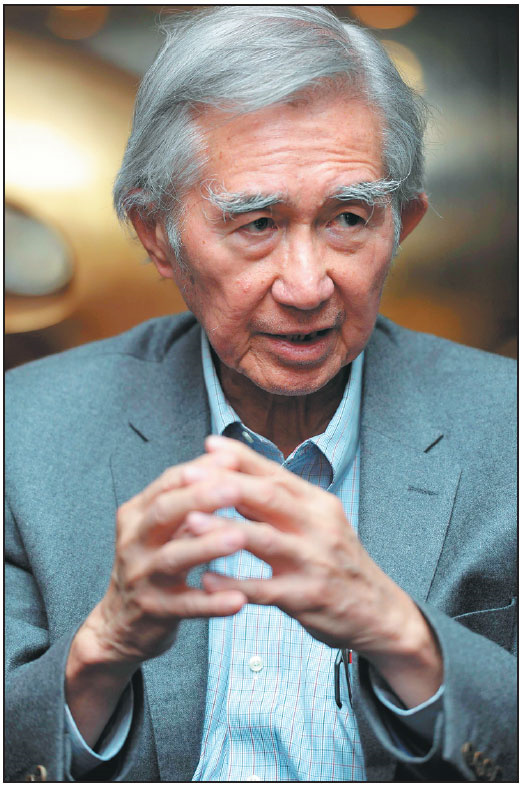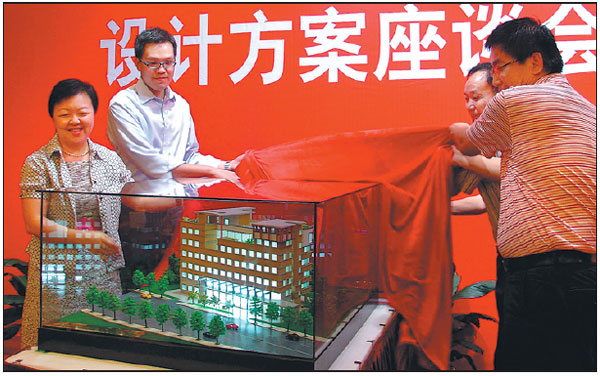The man who helped design China's urban landscape
Since meeting with Deng Xiaoping in 1978, Singaporean has helped plan nearly 50 cities nationwide
 |
|
Liu Thai Ker talks with local media in Wuhan, Hubei province, on Nov 20, 2013.[ZHANG CHANG/CHINA NEWS SERVICE] |
He is best known as Singapore's "father of city planning", but Liu Thai Ker can also boast of having a hand in shaping the urban landscape in China.
You could say it started in 1978, when Deng Xiaoping visited Singapore.
"I was asked to take care of him as I could speak Mandarin well," recalled Liu, the chairman of Morrow Architects & Planners, who served as chief planner and CEO of Singapore's Urban Redevelopment Authority from 1989 to 1992.
Deng was taken to the rooftop of the Ministry of National Development building, where Liu explained Singapore's urban planning.
"I like to think that partly because of that, when Deng went back to China a few months later, he made the announcement (that China would learn) urban planning from Singapore," Liu, 80, said.
Back then, Liu was a junior staff member at the Housing and Development Board of Singapore, where he rose to become chief architect and CEO.
"I was an ignorant young man, but I knew that Deng was a very important reformer for China," he said. "He was very down-to-earth with no airs. He asked pointed, practical questions. I was very comfortable briefing him. He made a very good impression."
A year later, Liu made his first visit to China, where he made stops in Beijing, Tianjin and Shanghai, and had the chance to see the country at the start of reform and opening-up.
"I saw the historic parts of Beijing, with a lot of siheyuan," he said, referring to the capital's traditional courtyard homes. "Unfortunately, most of them are gone already.
"In those days, people in the street wore either black or blue colors. They were very drab-looking, and yet the historic buildings were so beautiful."
It wasn't until the early 1980s that Liu received his first commission to plan a city in China - Fuzhou, the capital of Fujian province - through the Singapore government.
His experience on the topic stems from planning new towns for Singapore, each capable of accommodating about 200,000 people. By the end of his 20-year HDB career in 1989, he had created 23 new towns, including public housing and complementary facilities and amenities for their residents, such as playgrounds for the children, and community centers for recreational activities.
"When I did the planning at HDB, I also planned the surroundings to protect the neighborhoods," Liu said. "This meant I would have to keep updated on the urban plan of Singapore. By extension, I had no problems planning a city."
 |
|
A model of the Fujian-Singapore Friendship Medical Service Center, designed by Liu, is unveiled in Xiamen, Fujian province, on Aug 8, 2009. The center was opened in 2011. [YANG FUSHAN/CHINA NEWS SERVICE] |
A lot of convincing
That the city in question was Fuzhou was probably no coincidence. The ethnic Chinese living in Singapore mostly had roots in southern Chinese provinces like Guangdong and Fujian.
"It was probably to encourage them to invest in China, too," Liu said.
On a more personal note, Liu's mother hailed from Fuzhou, which further compelled him to take up the commission.
"As a child, I heard a lot of stories about the city, so I was comfortable," he said. "For example, Fuzhou has the nicknames of Rongcheng (banyan tree city) and Sanshan (three hills). In fact, I went to Sanshan Primary School, established by the Fuzhou people living in Singapore."
One of the first things he did in Fuzhou was to look for the three hills. When he could not find them, he realized it was because there were no roads leading to the hills, and they were obstructed by buildings.
"I created roads around the hills so they can be seen more easily," he said.
Another cause he championed was the preservation of the city's historical buildings. The most famous area is Sanfangqixiang (three lanes, seven alleys), which had been home to the literati, government officials and the wealthy upper class. However, rather than preserve the area, the local authorities were determined to raze it to the ground.
"Those were beautiful buildings with unique styles that you don't see elsewhere in China," Liu said. "It took a lot of convincing not to demolish them."
He found himself repeating the same arguments when it came to the Minjiang River that runs through the city. Although it was filled with sewage, Liu could see its potential.
"They protested, but I forced them to select a site to put a sewage treatment plant to treat the sewage so the river would become clean," he said.
In the early 1990s, toward the end of Liu's work on the Fuzhou master plan, Xi Jinping, now president of China, was appointed Party secretary of Fuzhou.
Liu met with Xi to brief him on his plans for the city. Later, he was asked to design the Fuzhou Changle International Airport. "I said no because I had never planned an airport," Liu recalled.
A few months later, Xi visited Singapore and asked to see Liu privately, and again he broached the subject. "He said he appreciated two things about me: First, the timely delivery of the Fuzhou master plan, and second, its good quality."
Xi said if Liu could do that, then he was confident Liu could do the same for the airport. In the end, Liu accepted and had the Changi Airport Group help out.
An important learning point was not to underestimate the rate of urbanization in China. While Liu consciously planned for the long-term growth of the city, it developed much faster than anticipated.
"The change of China is really dramatic," he said. "In those days, when I planned the area, I thought it would last a long time. But actually the rate of urbanization has moved much faster than that."
Last year, the Fuzhou government knocked on his door again to ask him to plan greater Fuzhou, which will stretch all the way to the coast. He is now working on the master plan.
Back in the '80s, before he finished planning Fuzhou, Liu received his second commission - for Xiamen Island, also in Fujian. Again, the thirst for progress drove the authorities to want to pull down historic buildings to replace them with skyscrapers.
Liu said: "I told them if you insist on pulling down these buildings, it's like throwing the gold mine of tourism into the sea. Do you really want to do that?"
Today, visitors to Xiamen Island can see a neighborhood of heritage shophouses that Liu saved from demolition. They can also make a stop at Yuandang Lake, which Liu said was a "cesspit of sewage" when he first visited.
The authorities had insisted on breaking the dam that divided the lake and the sea, and let the water flow out.
"I told them it was one of the highlights of the city and that they were not allowed to," Liu said. "One day in a meeting, I sat down and said I'm not going to dismiss the meeting until we find the solution for a sewage treatment plant to treat the lake - so we talked until we did."
For many years now, Xiamen Island has been rated one of the most livable areas in China, Liu said with pride.
"Old habits die hard," he said. "You needed to give a lot of explanations to convince them. But I sensed they were all patriotic about rebuilding China, so if you told them it would be good for the city, at the end, they would accept."
Another noteworthy project was the master plan for Ningbo, Zhejiang province, which Liu did after he left the Singapore civil service to join RSP Architects Planners and Engineers as senior director.
To show just how important the project was to the Singapore government, the citystate's founding prime minister, Lee Kuan Yew, joined in the final presentation of the concept to the Ningbo authorities.
Liu remembers wanting to plan the area around the port.
"It took me three and a half hours to drive there," he said. "Ten years later, when I returned to the city and asked them to show it to me, it took me 35 minutes to drive to the port. That's the power of planning."
Architectural history
A more recent project is one in Xi'an that was approved in 2016. It is a master plan for a new central business district that will connect the capital of northwestern China's Shaanxi province with Xianyang, a neighboring historic city to the west.
Integral to the plan is a line linking the central business district to a site dating back to the Northern Zhou Dynasty (557-581).
Rather than ignore such an ancient site, Liu included a pedestrian walkway along the line that will be paved with contemporary buildings designed in architectural styles progressing from the Northern Zhou Dynasty to the Qing Dynasty (1644-1911).
"When you walk along this line, you walk through China's architectural history," he said.
Liu has planned close to 50 cities in China over almost 35 years. More are in the pipeline, in places such as Qingdao, Yantai and Jinan, all in Shandong province.
Two years ago, he was appointed chief planning adviser to Yunnan province and has been busy working on plans for greater Kunming, Shangri-la and Dali.
He said urbanization in China has become more sophisticated, thanks in part to the Chinese people and their extensive travels. This has inevitably affected the way Liu designs master plans for his Chinese clients.
"I have to provide a greater range of urban facilities to satisfy their needs," he said "For example, I have to show them more clearly the education plan, such as the location of the universities.
"In the past two to three years, President Xi Jinping has been emphasizing more than before about the importance of the protection of ecological areas. They are also more specific about what they want to use the space in the cities for."
Even as he works, Liu is conscientious about imparting his knowledge of urban planning to Chinese planners. He often uses the analogy of cooking, saying there are three things required to design a good city.
The first is good raw materials. Most cities in China have outstanding ones by way of historic buildings and gifts endowed by Mother Nature.
Second, the recipe must be well-written. Chinese urban planning needs help in this area, which is why he goes there to help them "write the recipe".
Third, good cooking skills are important. This means the implementation of the plan has to be strictly enforced.
"I describe the Singapore urban planning experience used by me as being updated, Asianized, Western planning theory," he said. "While the concept of urban planning originated from the West, it cannot be used wholesale in Asia, since 60 percent of the world's population lives on 30 percent of the world's land area - making it high-density. The demands on urban planning are more complex than before. For example, there are challenges like industrialization, pollution and traffic.
"This approach is not well understood in the West and China, therefore I feel they have not quite reached the level of understanding we take for granted in Singapore."
Still, Liu said he feels other Asian countries have plenty to learn from China.
"In the context of urban planning, China has four strengths," he said. "It has a strong government so if you have a good idea, it will be implemented. It has total ownership of land. If you want to develop, the most important capital of development is the land. China is economically well off. Whenever there is the need for infrastructure investment, they can afford to do so.
"Finally, there has been a large amount of urbanization in the past four decades. The planners in China are more experienced and sophisticated than in many other places, which have not gone through the same process."
Liu often tells his Chinese clients that China, in the near future, will be the best country in the world in terms of its military, economics, culture and science. To complete the list, they must create good cities. "That part is their biggest challenge," he said.

 Print
Print Top 10 topics of international talents in 2018
Top 10 topics of international talents in 2018 Policies to attract foreign talent
Policies to attract foreign talent


